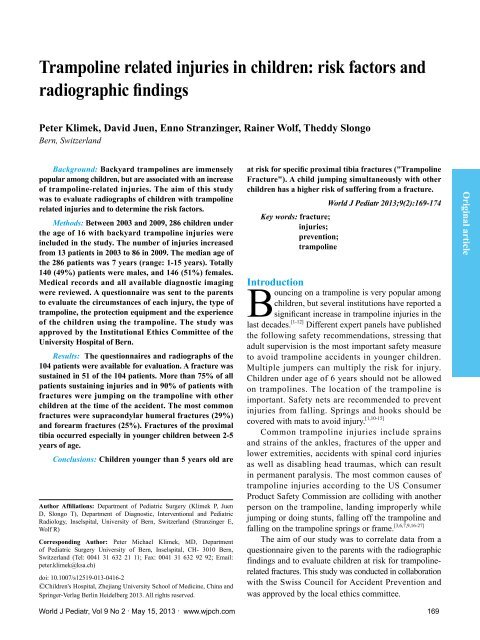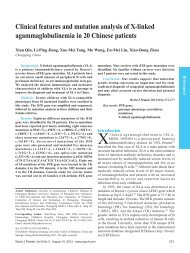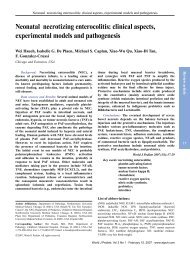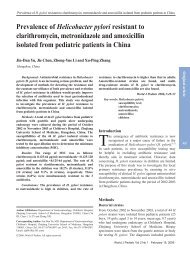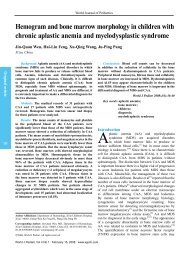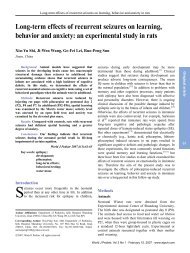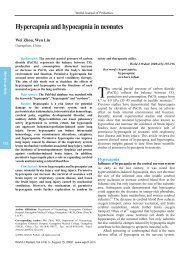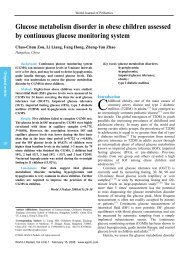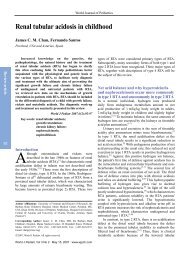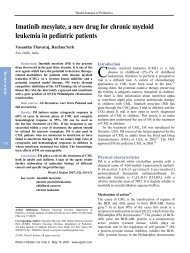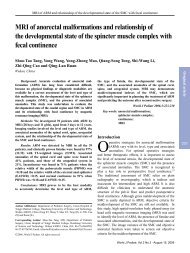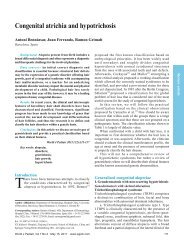Trampoline related injuries in children - World Journal of Pediatrics
Trampoline related injuries in children - World Journal of Pediatrics
Trampoline related injuries in children - World Journal of Pediatrics
You also want an ePaper? Increase the reach of your titles
YUMPU automatically turns print PDFs into web optimized ePapers that Google loves.
<strong>Trampol<strong>in</strong>e</strong> <strong>related</strong> <strong><strong>in</strong>juries</strong> <strong>in</strong> <strong>children</strong><br />
<strong>Trampol<strong>in</strong>e</strong> <strong>related</strong> <strong><strong>in</strong>juries</strong> <strong>in</strong> <strong>children</strong>: risk factors and<br />
radiographic f<strong>in</strong>d<strong>in</strong>gs<br />
Peter Klimek, David Juen, Enno Stranz<strong>in</strong>ger, Ra<strong>in</strong>er Wolf, Theddy Slongo<br />
Bern, Switzerland<br />
Background: Backyard trampol<strong>in</strong>es are immensely<br />
popular among <strong>children</strong>, but are associated with an <strong>in</strong>crease<br />
<strong>of</strong> trampol<strong>in</strong>e-<strong>related</strong> <strong><strong>in</strong>juries</strong>. The aim <strong>of</strong> this study<br />
was to evaluate radiographs <strong>of</strong> <strong>children</strong> with trampol<strong>in</strong>e<br />
<strong>related</strong> <strong><strong>in</strong>juries</strong> and to determ<strong>in</strong>e the risk factors.<br />
Methods: Between 2003 and 2009, 286 <strong>children</strong> under<br />
the age <strong>of</strong> 16 with backyard trampol<strong>in</strong>e <strong><strong>in</strong>juries</strong> were<br />
<strong>in</strong>cluded <strong>in</strong> the study. The number <strong>of</strong> <strong><strong>in</strong>juries</strong> <strong>in</strong>creased<br />
from 13 patients <strong>in</strong> 2003 to 86 <strong>in</strong> 2009. The median age <strong>of</strong><br />
the 286 patients was 7 years (range: 1-15 years). Totally<br />
140 (49%) patients were males, and 146 (51%) females.<br />
Medical records and all available diagnostic imag<strong>in</strong>g<br />
were reviewed. A questionnaire was sent to the parents<br />
to evaluate the circumstances <strong>of</strong> each <strong>in</strong>jury, the type <strong>of</strong><br />
trampol<strong>in</strong>e, the protection equipment and the experience<br />
<strong>of</strong> the <strong>children</strong> us<strong>in</strong>g the trampol<strong>in</strong>e. The study was<br />
approved by the Institutional Ethics Committee <strong>of</strong> the<br />
University Hospital <strong>of</strong> Bern.<br />
Results: The questionnaires and radiographs <strong>of</strong> the<br />
104 patients were available for evaluation. A fracture was<br />
susta<strong>in</strong>ed <strong>in</strong> 51 <strong>of</strong> the 104 patients. More than 75% <strong>of</strong> all<br />
patients susta<strong>in</strong><strong>in</strong>g <strong><strong>in</strong>juries</strong> and <strong>in</strong> 90% <strong>of</strong> patients with<br />
fractures were jump<strong>in</strong>g on the trampol<strong>in</strong>e with other<br />
<strong>children</strong> at the time <strong>of</strong> the accident. The most common<br />
fractures were supracondylar humeral fractures (29%)<br />
and forearm fractures (25%). Fractures <strong>of</strong> the proximal<br />
tibia occurred especially <strong>in</strong> younger <strong>children</strong> between 2-5<br />
years <strong>of</strong> age.<br />
Conclusions: Children younger than 5 years old are<br />
Author Affiliations: Department <strong>of</strong> Pediatric Surgery (Klimek P, Juen<br />
D, Slongo T), Department <strong>of</strong> Diagnostic, Interventional and Pediatric<br />
Radiology, Inselspital, University <strong>of</strong> Bern, Switzerland (Stranz<strong>in</strong>ger E,<br />
Wolf R)<br />
Correspond<strong>in</strong>g Author: Peter Michael Klimek, MD, Department<br />
<strong>of</strong> Pediatric Surgery University <strong>of</strong> Bern, Inselspital, CH- 3010 Bern,<br />
Switzerland (Tel: 0041 31 632 21 11; Fax: 0041 31 632 92 92; Email:<br />
peter.klimek@ksa.ch)<br />
doi: 10.1007/s12519-013-0416-2<br />
©Children's Hospital, Zhejiang University School <strong>of</strong> Medic<strong>in</strong>e, Ch<strong>in</strong>a and<br />
Spr<strong>in</strong>ger-Verlag Berl<strong>in</strong> Heidelberg 2013. All rights reserved.<br />
at risk for specific proximal tibia fractures ("<strong>Trampol<strong>in</strong>e</strong><br />
Fracture"). A child jump<strong>in</strong>g simultaneously with other<br />
<strong>children</strong> has a higher risk <strong>of</strong> suffer<strong>in</strong>g from a fracture.<br />
<strong>World</strong> J Pediatr 2013;9(2):169-174<br />
Key words: fracture;<br />
<strong><strong>in</strong>juries</strong>;<br />
prevention;<br />
trampol<strong>in</strong>e<br />
Introduction<br />
Bounc<strong>in</strong>g on a trampol<strong>in</strong>e is very popular among<br />
<strong>children</strong>, but several <strong>in</strong>stitutions have reported a<br />
significant <strong>in</strong>crease <strong>in</strong> trampol<strong>in</strong>e <strong><strong>in</strong>juries</strong> <strong>in</strong> the<br />
last decades. [1-12] Different expert panels have published<br />
the follow<strong>in</strong>g safety recommendations, stress<strong>in</strong>g that<br />
adult supervision is the most important safety measure<br />
to avoid trampol<strong>in</strong>e accidents <strong>in</strong> younger <strong>children</strong>.<br />
Multiple jumpers can multiply the risk for <strong>in</strong>jury.<br />
Children under age <strong>of</strong> 6 years should not be allowed<br />
on trampol<strong>in</strong>es. The location <strong>of</strong> the trampol<strong>in</strong>e is<br />
important. Safety nets are recommended to prevent<br />
<strong><strong>in</strong>juries</strong> from fall<strong>in</strong>g. Spr<strong>in</strong>gs and hooks should be<br />
covered with mats to avoid <strong>in</strong>jury. [1,10-15]<br />
Common trampol<strong>in</strong>e <strong><strong>in</strong>juries</strong> <strong>in</strong>clude spra<strong>in</strong>s<br />
and stra<strong>in</strong>s <strong>of</strong> the ankles, fractures <strong>of</strong> the upper and<br />
lower extremities, accidents with sp<strong>in</strong>al cord <strong><strong>in</strong>juries</strong><br />
as well as disabl<strong>in</strong>g head traumas, which can result<br />
<strong>in</strong> permanent paralysis. The most common causes <strong>of</strong><br />
trampol<strong>in</strong>e <strong><strong>in</strong>juries</strong> accord<strong>in</strong>g to the US Consumer<br />
Product Safety Commission are collid<strong>in</strong>g with another<br />
person on the trampol<strong>in</strong>e, land<strong>in</strong>g improperly while<br />
jump<strong>in</strong>g or do<strong>in</strong>g stunts, fall<strong>in</strong>g <strong>of</strong>f the trampol<strong>in</strong>e and<br />
fall<strong>in</strong>g on the trampol<strong>in</strong>e spr<strong>in</strong>gs or frame. [3,6,7,9,16-27]<br />
The aim <strong>of</strong> our study was to correlate data from a<br />
questionnaire given to the parents with the radiographic<br />
f<strong>in</strong>d<strong>in</strong>gs and to evaluate <strong>children</strong> at risk for trampol<strong>in</strong>e<strong>related</strong><br />
fractures. This study was conducted <strong>in</strong> collaboration<br />
with the Swiss Council for Accident Prevention and<br />
was approved by the local ethics committee.<br />
Orig<strong>in</strong>al article<br />
<strong>World</strong> J Pediatr, Vol 9 No 2 . May 15, 2013 . www.wjpch.com<br />
169
<strong>World</strong> <strong>Journal</strong> <strong>of</strong> <strong>Pediatrics</strong><br />
Orig<strong>in</strong>al article<br />
Methods<br />
Between 2003 and 2009, all <strong>children</strong> (age
<strong>Trampol<strong>in</strong>e</strong> <strong>related</strong> <strong><strong>in</strong>juries</strong> <strong>in</strong> <strong>children</strong><br />
In 85% <strong>of</strong> all cases reviewed the surface under and<br />
around the trampol<strong>in</strong>e was grass, <strong>in</strong> 11% it was stone,<br />
and <strong>in</strong> 4% <strong>of</strong> the cases, gravel.<br />
Over 75% <strong>of</strong> the <strong>children</strong> <strong>in</strong>volved <strong>in</strong> an accident,<br />
and 90% <strong>of</strong> the <strong>children</strong> with fracture or other severe<br />
<strong>in</strong>jury were jump<strong>in</strong>g together with other <strong>children</strong> at the<br />
time <strong>of</strong> the accident. Parental supervision was evident<br />
<strong>in</strong> more than a quarter (28 <strong>of</strong> 104, 27%) <strong>of</strong> the cases.<br />
In 44% <strong>of</strong> the <strong>children</strong>, a trampol<strong>in</strong>e with a security net<br />
was used outside <strong>of</strong> the frame (Type B, Fig. 1C). Only<br />
36% <strong>of</strong> the <strong>in</strong>jured <strong>children</strong> used a trampol<strong>in</strong>e without<br />
net.<br />
The majority <strong>of</strong> the accidents (n=104) occurred<br />
on trampol<strong>in</strong>e type A and B (35%, 44% respectively).<br />
Fractures (n=51) were found <strong>in</strong> 29% <strong>of</strong> the cases <strong>in</strong><br />
type A and <strong>in</strong> 43% <strong>in</strong> type B; 12% <strong>of</strong> the accidents<br />
were counted on type C and 9% on type D. Fractures<br />
occurred <strong>in</strong> 20% on type C and <strong>in</strong> 8% on type D.<br />
Twenty-eight <strong>of</strong> the 104 (27%) accidents resulted<br />
from trampol<strong>in</strong>es with a diameter less than 300 cm. In<br />
14 <strong>of</strong> the 28 (50%) cases, we found one bone fracture.<br />
Seventy-two (69%) accidents happened on trampol<strong>in</strong>es<br />
with a diameter over 300 cm. Of these, we found a<br />
bone fracture <strong>in</strong> 35 <strong>of</strong> 72 (49%). The trampol<strong>in</strong>e size<br />
was unknown <strong>in</strong> 4%. Most <strong>of</strong> the accidents (47 <strong>of</strong> 104,<br />
45%) happened after 10 to 20 m<strong>in</strong>utes <strong>of</strong> jump<strong>in</strong>g, 16%<br />
with<strong>in</strong> the first 10 m<strong>in</strong>utes, 33% after 20 m<strong>in</strong>utes, and<br />
6% were unknown.<br />
Forty-three <strong>of</strong> the 104 (41%) <strong>in</strong>jured <strong>children</strong> had<br />
a jump<strong>in</strong>g experience less than 25 days. Among them,<br />
23 (53%) had a fracture. Twenty-eight (27%) had a<br />
jump<strong>in</strong>g experience <strong>of</strong> 25-100 days, and 16 (57%) had<br />
a fracture. Only <strong>children</strong> with a jump<strong>in</strong>g experience <strong>of</strong><br />
over 100 days (26 <strong>children</strong> with 10 fractures) showed a<br />
decreased <strong>in</strong>cidence <strong>of</strong> fractures (38%).<br />
We contacted all trampol<strong>in</strong>e distributors <strong>in</strong><br />
Switzerland to ask for the number <strong>of</strong> purchased<br />
trampol<strong>in</strong>es <strong>in</strong> the study period. Only one <strong>of</strong> them<br />
answered that they had an <strong>in</strong>crease <strong>of</strong> 466% <strong>in</strong> sales<br />
from 2003 to 2009.<br />
years <strong>in</strong> the proximal tibia metaphysis (n=5) (Fig.<br />
3). Special attention has to be paid on proximal tibia<br />
fractures <strong>in</strong> younger <strong>children</strong> (2-5 years old). Because<br />
<strong>of</strong> axial forces, the proximal tibia is at risk for<br />
impression fractures with anterior angulation and early<br />
closure <strong>of</strong> the growth plates. This fracture type may<br />
appear very subtle on <strong>in</strong>itial radiographs and may be<br />
overlooked. In case <strong>of</strong> not conclusive radiographs and<br />
persistent pa<strong>in</strong> <strong>of</strong> the tibia, follow-up radiographs after<br />
7-10 days are recommended. In most <strong>of</strong> the <strong>children</strong>,<br />
a compression type fracture with anterior angulation<br />
<strong>of</strong> the growth plate was noted. There were always<br />
more than two <strong>children</strong> jump<strong>in</strong>g on the trampol<strong>in</strong>e<br />
when proximal tibia fractures occurred. Most <strong>of</strong><br />
the proximal tibial fractures occurred <strong>in</strong> spr<strong>in</strong>gtime<br />
between April and June.<br />
Chronic repetitive changes [sclerosis <strong>of</strong> the<br />
metaphysis, growth arrest l<strong>in</strong>es (Harris l<strong>in</strong>es), widen<strong>in</strong>g<br />
Fig. 2. A 6-year-old boy, dropped on the ground, with a supracondylar<br />
humeral fracture. Supracondylar fracture l<strong>in</strong>e (white arrow) and jo<strong>in</strong>t<br />
effusion (black arrow) is noted.<br />
Orig<strong>in</strong>al article<br />
Radiographic results<br />
A fracture was found <strong>in</strong> 51 <strong>of</strong> the 104 patients. The<br />
most common fractures were upper extremity fractures<br />
(n=35) such as supracondylar humeral fractures (15 <strong>of</strong><br />
35) and forearm fractures (13 <strong>of</strong> 35) (Fig. 2). Upper<br />
extremity fractures occurred frequently with direct<br />
impact on the ground (15 <strong>of</strong> 35), followed by collision<br />
with other <strong>children</strong> (9 <strong>of</strong> 35) and collision with frame<br />
(4 <strong>of</strong> 35). No chronic or repetitive changes <strong>of</strong> the upper<br />
extremities were found.<br />
Lower extremity fractures were noted <strong>in</strong> 15<br />
patients. Characteristic trampol<strong>in</strong>e fractures <strong>of</strong> the<br />
lower extremities occurred <strong>in</strong> <strong>children</strong> aged 2-5<br />
<strong>World</strong> J Pediatr, Vol 9 No 2 . May 15, 2013 . www.wjpch.com<br />
Fig. 3. A 2-year-old girl with characteristic right proximal tibia<br />
fracture (arrow). Three months later, the same fracture occurred on<br />
the left side. Mild anterior angulation <strong>of</strong> the growth plates on lateral<br />
radiographs is noted.<br />
171
<strong>World</strong> <strong>Journal</strong> <strong>of</strong> <strong>Pediatrics</strong><br />
Orig<strong>in</strong>al article<br />
Fig. 4. A 13-year-old girl with sup<strong>in</strong>ation trauma <strong>of</strong> the ankle. A:<br />
<strong>in</strong>itial radiograph with widen<strong>in</strong>g <strong>of</strong> the fibular growth plate likely<br />
avulsion force (arrow) and swell<strong>in</strong>g <strong>of</strong> the lateral malleolus; B: onemonth<br />
follow-up radiograph with narrow<strong>in</strong>g <strong>of</strong> the growth plate <strong>of</strong> the<br />
fibula (arrow) and tibia (consistent with early closure).<br />
Fig. 6. A 4-year-old girl with sclerosis <strong>of</strong> the metaphysis (large white<br />
arrow), widen<strong>in</strong>g <strong>of</strong> the medial femoral growth plate (asterisk) and<br />
growth arrest l<strong>in</strong>es (small white arrow).<br />
<strong>of</strong> the growth plates] or Salter-Harris type fractures<br />
were found <strong>in</strong> 5 out <strong>of</strong> 15 <strong>children</strong> with fracture <strong>of</strong> the<br />
lower extremity. In two <strong>children</strong>, early closure <strong>of</strong> the<br />
growth plates was noted <strong>in</strong> follow-up radiographs (Figs.<br />
4-6).<br />
Fig. 5. A 7-year-old girl with Salter Harris Type I fracture <strong>of</strong> the distal<br />
femur (arrow); <strong>in</strong>itial radiograph (A), follow-up radiographs after one<br />
month (B) and 7 months (C) with early closure <strong>of</strong> the medial growth<br />
plate (white arrow) <strong>of</strong> the femur and growth arrest l<strong>in</strong>es (black arrow).<br />
trampol<strong>in</strong>e use. [3,12,14] Parental supervision is one <strong>of</strong> the<br />
most important factors <strong>in</strong> reduc<strong>in</strong>g risk <strong>of</strong> <strong><strong>in</strong>juries</strong> on<br />
a trampol<strong>in</strong>e. [31] In our study, parental supervision was<br />
evident only <strong>in</strong> 27% <strong>of</strong> the accidents.<br />
Another important risk factor is the number <strong>of</strong> <strong>children</strong><br />
jump<strong>in</strong>g simultaneously on the trampol<strong>in</strong>e. [6,10,11,19,20,32]<br />
In our study, 75% <strong>of</strong> the accidents and more than 90%<br />
<strong>of</strong> the fractures occurred while more than one child<br />
was on the trampol<strong>in</strong>e. Our data showed that neither a<br />
net nor larger diameter <strong>of</strong> the trampol<strong>in</strong>e can protect<br />
<strong>children</strong> from severe <strong><strong>in</strong>juries</strong>.<br />
Shields et al [33] also reported a similar level <strong>of</strong> severity<br />
<strong>of</strong> <strong><strong>in</strong>juries</strong> for small and larger trampol<strong>in</strong>es. Most <strong>of</strong> the<br />
bone fractures occurred on net-secured trampol<strong>in</strong>es, thus<br />
a net may provoke <strong>children</strong> to more exaggerated jump<strong>in</strong>g.<br />
A jump<strong>in</strong>g experience over 100 days seems to decrease<br />
the risk for accidents and fractures, although this may not<br />
be statistically significant. Children between 2-6 years<br />
<strong>of</strong> age are at the highest risk to suffer a bone fracture<br />
due to trampol<strong>in</strong>e accidents and most fractures occur <strong>in</strong><br />
spr<strong>in</strong>g. Those facts may be due to age-<strong>related</strong> physiologic<br />
weakness and osteopenia <strong>in</strong> spr<strong>in</strong>g and early summertime<br />
caused by vitam<strong>in</strong> D deficiency and less activity dur<strong>in</strong>g<br />
w<strong>in</strong>ter months, together with an <strong>in</strong>creased activity <strong>in</strong><br />
spr<strong>in</strong>g and early summer. [34,35]<br />
Discussion<br />
The <strong>in</strong>creas<strong>in</strong>g popularity <strong>of</strong> backyard trampol<strong>in</strong>es is<br />
associated with a rapidly ris<strong>in</strong>g <strong>in</strong>cidence <strong>of</strong> <strong><strong>in</strong>juries</strong>.<br />
Because <strong>of</strong> the <strong>in</strong>creased rate <strong>of</strong> <strong><strong>in</strong>juries</strong>, some authors<br />
regard the use <strong>of</strong> trampol<strong>in</strong>es for recreational purposes<br />
as <strong>in</strong>herently unsafe and others even recommend<br />
bann<strong>in</strong>g backyard trampol<strong>in</strong>es. [6,18,19,29,30]<br />
Several authors suggest promot<strong>in</strong>g parental and<br />
public awareness regard<strong>in</strong>g the potential dangers <strong>of</strong><br />
172<br />
Radiographic f<strong>in</strong>d<strong>in</strong>gs<br />
Two different mechanisms may expla<strong>in</strong> the different<br />
upper and lower extremity f<strong>in</strong>d<strong>in</strong>gs on radiographs.<br />
While the upper extremities show more fractures<br />
(supracondylar humerus fractures, forearm fractures,<br />
etc) due to direct impact on the ground or the frame<br />
<strong>of</strong> the trampol<strong>in</strong>e, the lower extremities have a higher<br />
<strong>in</strong>cidence <strong>of</strong> chronic repetitive changes. Axial forces<br />
to the ankle and knee jo<strong>in</strong>ts may expla<strong>in</strong> growth arrest<br />
l<strong>in</strong>es, widen<strong>in</strong>g <strong>of</strong> the growth plates or sclerosis <strong>of</strong> the<br />
<strong>World</strong> J Pediatr, Vol 9 No 2 . May 15, 2013 . www.wjpch.com
<strong>Trampol<strong>in</strong>e</strong> <strong>related</strong> <strong><strong>in</strong>juries</strong> <strong>in</strong> <strong>children</strong><br />
metaphysis. Although early closure after Salter type I<br />
fractures may occur, it is a very rare complication.<br />
Multiple <strong>children</strong> on the trampol<strong>in</strong>e may <strong>in</strong>crease<br />
the axial forces to the knee jo<strong>in</strong>t and may cause the<br />
typical proximal tibia fractures <strong>in</strong> <strong>children</strong> less than 6<br />
years <strong>of</strong> age ("<strong>Trampol<strong>in</strong>e</strong> Fracture"). [17,36,37] Swischuk<br />
and Boyer et al [17,37] concluded that the most common<br />
lower extremity <strong>in</strong>jury is a hyperextension <strong>in</strong>jury <strong>of</strong> the<br />
knee, result<strong>in</strong>g <strong>in</strong> a compression fracture <strong>of</strong> the upper<br />
tibia. Those <strong>children</strong> are <strong>of</strong>ten between 2-6 years <strong>of</strong> age.<br />
Prevention<br />
In our op<strong>in</strong>ion, a ban on the <strong>in</strong>creas<strong>in</strong>g and popular<br />
backyard trampol<strong>in</strong>es is impossible. Sport<strong>in</strong>g activity<br />
for <strong>children</strong> should be encouraged, but trampol<strong>in</strong>e<br />
use should be undertaken with adult supervision and<br />
<strong>in</strong> accordance with safety procedures. Schoenholzer<br />
et al [38] noted <strong>in</strong> 1962 the difficulty <strong>of</strong> the "benefit" <strong>of</strong><br />
a sport. Consider<strong>in</strong>g factors like the development <strong>of</strong><br />
physical strength, coord<strong>in</strong>ation or psychic well-be<strong>in</strong>g,<br />
trampol<strong>in</strong>e jump<strong>in</strong>g is an excellent opportunity to<br />
improve the perception <strong>of</strong> body and space.<br />
Based on our data, the Swiss Council for Accident<br />
Prevention is prepar<strong>in</strong>g new safety recommendations<br />
for all parents for trampol<strong>in</strong>e use ("bfu-Children's<br />
Mail") <strong>in</strong> Switzerland. The brochure is adapted to the<br />
particular development <strong>of</strong> <strong>children</strong> and <strong>in</strong>forms parents<br />
about typical accident risks. "bfu-Children's Mail"<br />
<strong>in</strong>cludes 16 issues, start<strong>in</strong>g with the birth <strong>of</strong> a child and<br />
to be delivered for free to the parents every 6 months.<br />
In conclusion, the frequency <strong>of</strong> trampol<strong>in</strong>e<br />
<strong>related</strong> <strong><strong>in</strong>juries</strong> <strong>in</strong> <strong>children</strong> is <strong>in</strong>creas<strong>in</strong>g. Infants and<br />
<strong>children</strong> between 2-5 years <strong>of</strong> age are at higher risk<br />
to suffer from characteristic proximal metaphyseal<br />
tibia fractures. These <strong>children</strong> almost jump together<br />
with other <strong>children</strong> or persons on the trampol<strong>in</strong>e at the<br />
time <strong>of</strong> <strong>in</strong>jury, which may lead to higher axial forces<br />
to the lower extremities. Supervision by the parents<br />
is especially important <strong>in</strong> this age group. Chronic<br />
repetitive changes <strong>of</strong> growth plates <strong>in</strong> the lower<br />
extremities and early fusion <strong>of</strong> the growth plates may<br />
occur.<br />
Acknowledgements<br />
Andrea Kehl & Marianne Kraus, study nurses. Othmar Brügger<br />
(Swiss Council for Accident Prevention) for the cooperation.<br />
Miriam Klimek for correction and translation.<br />
Fund<strong>in</strong>g: None.<br />
Ethical approval: The study was approved by the <strong>in</strong>stitutional<br />
ethics committee <strong>of</strong> the University Hospital <strong>of</strong> Bern.<br />
Compet<strong>in</strong>g <strong>in</strong>terest: None <strong>of</strong> the authors has f<strong>in</strong>ancial or<br />
personal relationships with other persons or organizations that<br />
could <strong>in</strong>appropriately <strong>in</strong>fluence his or her actions.<br />
Contributors: Klimek P and Juen D wrote the ma<strong>in</strong> body <strong>of</strong> the<br />
article. Stranz<strong>in</strong>ger E and Wolf R provided advice on radiological<br />
aspects. Slongo T is the guarantor.<br />
References<br />
1 American Academy <strong>of</strong> <strong>Pediatrics</strong>. Committee on Injury and<br />
Poison Prevention and Committee on Sports Medic<strong>in</strong>e and<br />
Fitness. <strong>Trampol<strong>in</strong>e</strong>s at home, school, and recreational centers.<br />
<strong>Pediatrics</strong> 1999;103:1053-1056.<br />
2 <strong>Trampol<strong>in</strong>e</strong> use <strong>in</strong> homes and playgrounds. Paediatr Child Health<br />
2007;12:501-511.<br />
3 Bhangal KK, Neen D, Dodds R. Incidence <strong>of</strong> trampol<strong>in</strong>e <strong>related</strong><br />
pediatric large district general hospital <strong>in</strong> the United K<strong>in</strong>gdom:<br />
lessons to be learnt. Inj Prev 2006;12:133-134.<br />
4 Chalmers DJ, Hume PA, Wilson BD. <strong>Trampol<strong>in</strong>e</strong>s <strong>in</strong> New<br />
Zealand: a decade <strong>of</strong> <strong><strong>in</strong>juries</strong>. Br J Sports Med 1994;28:234-238.<br />
5 Esposito PW, Esposito LM. The reemergence <strong>of</strong> the trampol<strong>in</strong>e<br />
as a recreational activity and competitive sport. Curr Sports Med<br />
Rep 2009;8:273-277.<br />
6 Furnival RA, Street KA, Schunk JE. Too many pediatric<br />
trampol<strong>in</strong>e <strong><strong>in</strong>juries</strong>. <strong>Pediatrics</strong> 1999;103:e57.<br />
7 Hartmann KE, Calikoglu MG. <strong>Trampol<strong>in</strong>e</strong>-<strong>related</strong> <strong><strong>in</strong>juries</strong> to<br />
<strong>children</strong>. <strong>Pediatrics</strong> 1999;103:1311-1312; author reply 1312-<br />
1313.<br />
8 Larson BJ, Davis JW. <strong>Trampol<strong>in</strong>e</strong>-<strong>related</strong> <strong><strong>in</strong>juries</strong>. J Bone Jo<strong>in</strong>t<br />
Surg Am 1995;77:1174-1178.<br />
9 Loken-Dahle L. <strong>Trampol<strong>in</strong>e</strong>-<strong>related</strong> <strong><strong>in</strong>juries</strong> <strong>in</strong> <strong>children</strong>.<br />
<strong>Pediatrics</strong> 1999;103:1312; author reply 1312-1313.<br />
10 Smith GA. Injuries to <strong>children</strong> <strong>in</strong> the United States <strong>related</strong><br />
to trampol<strong>in</strong>es, 1990-1995: a national epidemic. <strong>Pediatrics</strong><br />
1998;101:406-412.<br />
11 Woodward GA, Furnival R, Schunk JE. <strong>Trampol<strong>in</strong>e</strong>s revisited:<br />
a review <strong>of</strong> 114 pediatric recreational trampol<strong>in</strong>e <strong><strong>in</strong>juries</strong>.<br />
<strong>Pediatrics</strong> 1992;89:849-854.<br />
12 Wootton M, Harris D. Trampol<strong>in</strong><strong>in</strong>g <strong><strong>in</strong>juries</strong> present<strong>in</strong>g to a<br />
<strong>children</strong>'s emergency department. Emerg Med J 2009;26:728-<br />
731.<br />
13 Rapp GF. II. Safety suggestions for trampol<strong>in</strong>e use. Pediatr Ann<br />
1978;7:730-731.<br />
14 Rattya J, Serlo W. Us<strong>in</strong>g a safety net and follow<strong>in</strong>g the safety<br />
<strong>in</strong>structions could prevent half the paediatric trampol<strong>in</strong>e <strong><strong>in</strong>juries</strong>.<br />
Eur J Pediatr Surg 2008;18:261-265.<br />
15 Torg JS, Das M. <strong>Trampol<strong>in</strong>e</strong>-<strong>related</strong> quadriplegia: review <strong>of</strong> the<br />
literature and reflections on the American Academy <strong>of</strong> <strong>Pediatrics</strong>'<br />
position statement. <strong>Pediatrics</strong> 1984;74:804-812.<br />
16 Black GB, Amadeo R. Orthopedic <strong><strong>in</strong>juries</strong> associated with<br />
backyard trampol<strong>in</strong>e use <strong>in</strong> <strong>children</strong>. Can J Surg 2003;46:199-<br />
201.<br />
17 Boyer RS, Jaffe RB, Nixon GW, Condon VR. <strong>Trampol<strong>in</strong>e</strong><br />
fracture <strong>of</strong> the proximal tibia <strong>in</strong> <strong>children</strong>. AJR Am J Roentgenol<br />
1986;146:83-85.<br />
18 Brown PG, Lee M. <strong>Trampol<strong>in</strong>e</strong> <strong><strong>in</strong>juries</strong> <strong>of</strong> the cervical sp<strong>in</strong>e.<br />
Pediatr Neurosurg 2000;32:170-175.<br />
19 Eberl R, Schalamon J, S<strong>in</strong>ger G, Huber SS, Spitzer P, Hölwarth<br />
ME. <strong>Trampol<strong>in</strong>e</strong>-<strong>related</strong> <strong><strong>in</strong>juries</strong> <strong>in</strong> childhood. Eur J Pediatr<br />
2009;168:1171-1174.<br />
20 Esposito PW. <strong>Trampol<strong>in</strong>e</strong> <strong><strong>in</strong>juries</strong>. Cl<strong>in</strong> Orthop Relat Res<br />
Orig<strong>in</strong>al article<br />
<strong>World</strong> J Pediatr, Vol 9 No 2 . May 15, 2013 . www.wjpch.com<br />
173
<strong>World</strong> <strong>Journal</strong> <strong>of</strong> <strong>Pediatrics</strong><br />
Orig<strong>in</strong>al article<br />
2003;(409):43-52.<br />
21 Hammer A, Schwartzbach AL, Paulev PE. <strong>Trampol<strong>in</strong>e</strong> tra<strong>in</strong><strong>in</strong>g<br />
<strong><strong>in</strong>juries</strong> - one hundred and n<strong>in</strong>ety-five cases. Br J Sports Med<br />
1981;15:151-158.<br />
22 Hume PA, Chalmers DJ, Wilson BD. <strong>Trampol<strong>in</strong>e</strong> <strong>in</strong>jury <strong>in</strong> New<br />
Zealand: emergency care. Br J Sports Med 1996;30:327-330.<br />
23 Kravitz H. Problems with the trampol<strong>in</strong>e: I. Too many cases <strong>of</strong><br />
permanent paralysis. Pediatr Ann 1978;7:728-729.<br />
24 McDermott C, Qu<strong>in</strong>lan JF, Kelly IP. <strong>Trampol<strong>in</strong>e</strong> <strong><strong>in</strong>juries</strong> <strong>in</strong><br />
<strong>children</strong>. J Bone Jo<strong>in</strong>t Surg Br 2006;88:796-798.<br />
25 Nysted M, Drogset JO. <strong>Trampol<strong>in</strong>e</strong> <strong><strong>in</strong>juries</strong>. Br J Sports Med<br />
2006;40:984-987.<br />
26 Rapp GF, Nicely PG. <strong>Trampol<strong>in</strong>e</strong> <strong><strong>in</strong>juries</strong>. Am J Sports Med<br />
1978;6:260-271.<br />
27 Shankar A, Williams K, Ryan M. <strong>Trampol<strong>in</strong>e</strong>-<strong>related</strong> <strong>in</strong>jury <strong>in</strong><br />
<strong>children</strong>. Pediatr Emerg Care 2006;22:644-646.<br />
28 Matter P, Buhler M. 35 years fracture documentation by the<br />
Work<strong>in</strong>g Group for Osteosynthesis Problems (AO). Swiss Surg<br />
1995;57-60.<br />
29 Hammer A, Schwartzbach AL, Paulev PE. Some risk factors <strong>in</strong><br />
trampol<strong>in</strong><strong>in</strong>g illustrated by six serious <strong><strong>in</strong>juries</strong>. Br J Sports Med<br />
1982;16:27-32.<br />
30 Leonard H, J<strong>of</strong>fe AR. Children present<strong>in</strong>g to a Canadian hospital<br />
with trampol<strong>in</strong>e-<strong>related</strong> cervical sp<strong>in</strong>e <strong><strong>in</strong>juries</strong>. Paediatr Child<br />
Health 2009;14:84-88.<br />
31 Smith GA, Shields BJ. <strong>Trampol<strong>in</strong>e</strong>-<strong>related</strong> <strong><strong>in</strong>juries</strong> to <strong>children</strong>.<br />
Arch Pediatr Adolesc Med 1998;152:694-699.<br />
32 Bogacz A, Paterson B, Babber A, Menelaws S, Drew T.<br />
<strong>Trampol<strong>in</strong>e</strong> <strong><strong>in</strong>juries</strong>. How to avoid <strong>in</strong>jury. BMJ 2009;338:<br />
b2197.<br />
33 Shields BJ, Fernandez SA, Smith GA. Comparison <strong>of</strong><br />
m<strong>in</strong>itrampol<strong>in</strong>e- and full-sized trampol<strong>in</strong>e-<strong>related</strong> <strong><strong>in</strong>juries</strong> <strong>in</strong> the<br />
United States, 1990-2002. <strong>Pediatrics</strong> 2005;116:96-103.<br />
34 Bloom E, Kle<strong>in</strong> EJ, Shushan D, Feldman KW. Variable<br />
presentations <strong>of</strong> rickets <strong>in</strong> <strong>children</strong> <strong>in</strong> the emergency department.<br />
Pediatr Emerg Care 2004;20:126-130.<br />
35 Chapman T, Sugar N, Done S, Marasigan J, Wambold N,<br />
Feldman K. Fractures <strong>in</strong> <strong>in</strong>fants and toddlers with rickets. Pediatr<br />
Radiol 2010;40:1184-1189.<br />
36 Clare PE. <strong>Trampol<strong>in</strong>e</strong> <strong><strong>in</strong>juries</strong> to the lower extremity. Two case<br />
reports. Am J Sports Med 1978;6:141-142.<br />
37 Swischuk LE. Jumped <strong>of</strong>f the trampol<strong>in</strong>e: fell on knee: pa<strong>in</strong>.<br />
Pediatr Emerg Care 2009;25:366-367.<br />
38 Schoenholzer G. <strong>Trampol<strong>in</strong>e</strong> jump<strong>in</strong>g from a medical viewpo<strong>in</strong>t.<br />
Schweiz Z Sportmed 1962;10:6-22.<br />
Received February 29, 2012<br />
Accepted after revision June 20, 2012<br />
174<br />
<strong>World</strong> J Pediatr, Vol 9 No 2 . May 15, 2013 . www.wjpch.com


